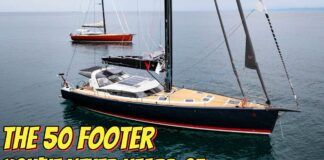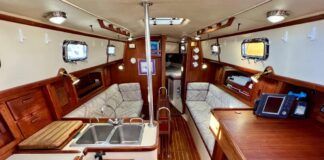The Islander 36 is a fairly light-displacement boat. The hand-laid hull is an uncored, single skin, with polyester resin and fiberglass furniture components adding rigidity. The hull and plywood-core deck are bolted together at close intervals through an aluminum toerail.
The majority of I36s had lead ballast attached with imbedded keel bolts, but some of the earlier models reportedly have iron ballast. The skeg-hung rudder is set in a bronze shoe that holds the bottom of the stainless rudder post.

Complaints about construction details of the Islander 36 are minimal and are primarily limited to such nuisance problems as leaking cabin ports and leaks at the hull/deck joint. Any number of commercial opening ports can be used as replacements for the original. (Many owners have reported using California-based Mark Plastics for fixed window replacements and acrylic forward hatch covers.) For the hull-deck leaks, owners simply re-bed the entire toerail. Some boat owners have reported blister issues, but by now, most of those have been addressed by current or previous owners. (The Islander 36 Owners Association website, www.islander36.org, is a great resource for I36 project pictures and guidance, as well as a list of vendors for original and replacement equipment.)
Potential I36 buyers should carefully check the boats chainplates and bulkheads in the main cabin. Also, be sure to sound the decks for delamination.
The narrow shroud base induces high rigging loads, so a careful examination of the hull structure in the way of the mast is a must on this boat, as it really is with any boat, new or old. Loads on the weather shrouds when going upwind in a blow can approach the total displacement of the boat, and lightly built boats cannot sacrifice strength in this area to save weight.
Buyers also should check the bulkhead that creates the forward anchor locker to ensure that the tabbing is secure to the hull; re-glassing the bulkheads, if needed, is a relatively inexpensive project.
The mast step also should be closely inspected. The original mast step was aluminum and did not have weep holes, so if water-particularly salt water-got into the mast, the mast and step became corrosion-welded to each other over time. A skilled owner can fix the problem, or it would be a relatively cost-effective boatyard fix.
Despite the fact that the boat was in production for more than a decade, there were relatively few significant changes in construction or detailing over the production history. The hull and deck molding remained almost unchanged, with more stylized fixed ports at the aft end of the main cabin. This was one of the few obvious exterior differences setting apart later boats. Owners in general consider the construction, fittings, and equipment to be of good quality for the boats intended use as a racer and coastal cruiser. We agree.





































Very good. Informative. Going to look at an I36 this will give me a huge heads up.